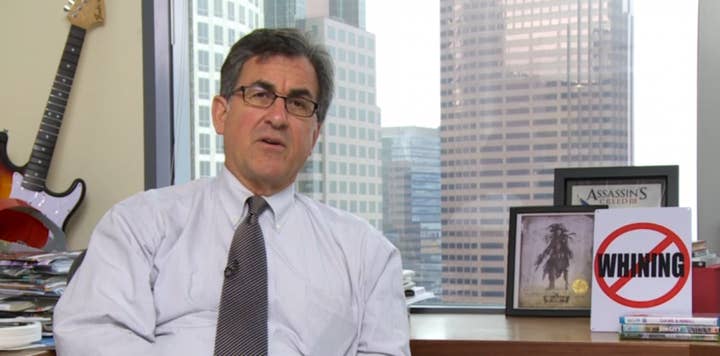Gaze Into The Future: Analyst Predictions for 2015
Xbox One to match PS4's installed base? VR out at a reasonable price? Our panel takes a stab at what we should expect next year
It's been a long and interesting year for the video games business, and with 2015 only a couple days away now, we've asked our regular analyst contributors to once again use their "special powers" to tell us what the future holds. And similar to last year, we're also asking our analyst panel to assess just how right or wrong they were with their previous set of predictions. The only exception is EEDAR's Patrick Walker who replaces Jesse Divnich from last time.
While you nod your head in agreement or chuckle in disapproval at the analysts' predictions, also be sure to take a glance at the sidebar on the right-hand side that includes a few predictions from the GamesIndustry.biz staff.
Happy New Year from all of us to you! See you in 2015!
Michael Pachter, Wedbush Securities

I predicted the PS4 would outsell the Xbox One due to price: Check. My prediction expected PS4 to outsell Xbox One by 20 - 25 percent; in 2014, PS4 outsold Xbox One by 18 percent, but since I said "summer", it is important to point out that PS4 outsold Xbox One by 59 percent in July/August/September.
I also predicted that Sony's lead would cause Microsoft to cut price "prior to the holidays" by "$100": Check. Microsoft cut by $100 in June. As part of that prediction, I said Sony would hold off making a pricing move until 2015: Check.
I predicted the Wii U would lag far behind: Check. Despite a year longer in the market, PS4 has outsold Wii U by 82 percent and Xbox One has outsold it by 59 percent.
I predicted an elusive cable subsidy deal for Microsoft in 2014: Wrong. Nothing happened, and I'm now thinking it will not happen at all.
I predicted Microsoft "might" unbundle Kinect: Check. This was clearly a driver of the $100 price cut, and gave them enough of a cost cushion to advertise their $349 bundles at holiday 2014.
This year, I think that we'll see:
Activision gaining traction in free-to-play. I think Hearthstone is only the beginning, and I think that Heroes of the Storm, Call of Duty Online and Overwatch will take Activision over $500 million in free-to-play revenues in 2015 and to $1 billion in 2016. The company really seems to have figured out how to play in this space, and I expect it to continue to thrive.
"the first month Sony re-takes the lead, Microsoft will react and cut price again. That probably happens in January"
Michael Pachter
Sony exclusives allowing it to keep its console sales lead. Assuming that Xbox One reverts to the $399 price point, I think that Sony first party software will make a real difference in 2015. The company has a phenomenal lineup of exclusives, and they're spread throughout the year. This should keep interest in the PS4 high, and should allow Sony to extend its lead.
Microsoft will be first to blink, with a price cut to $349. Microsoft appears to hate being in second place, and its success with the $349 price point and bundles at holiday suggest to me that the first month Sony re-takes the lead, Microsoft will react and cut price again. That probably happens in January, with some kind of bundle (Evolve? Battlefield Hardline?) in the spring from Microsoft.
Nintendo fails to re-ignite western third-party support. Although it didn't attract much media attention, it was a profound statement that neither Call of Duty nor Assassin's Creed were made for the Wii U in 2014. I think that shows that the western publishers have given up on the Wii U (following the lead of EA) and think that we'll see even less third-party software in 2014. Nintendo content remains compelling, but their big titles are too few and too far between to justify Wii U ownership for anyone other than hard core fans.
Microsoft does something interesting with Minecraft, and Amazon does something interesting with Twitch. These were big acquisitions in 2014, and both companies have the wherewithal to make something big happen. I expect Microsoft to brand Minecraft beyond games, and expect Amazon to build Twitch into a bigger media outlet.
Billy Pidgeon, independent analyst

2014 prediction 1: The overall games audience will remain at a plateau in 2014, but could be headed for a resurgence in 2015-2016.
I stand by my prediction concerning the games audience plateau in 2014 in saturated markets such as most of the western market. I still expect a resurgence of audience growth in 2015-2016, even in saturated markets, although this remains to be seen. Therefore, I'm extending this prediction for 2015. I should note also that I'm expecting growth not only in the fan base for casual games, but in the hardcore enthusiast base as well.
2015 prediction 1: The games audience will see overall growth in 2015. Casual and hardcore games will reach larger audiences this year.
Again, check this next year. Caveat: casual games providers could easily throw away great potential by continuing to skimp on gameplay quality and in-game transaction value. Mainstream gamers deserve better. (See prediction five.) I'm much more optimistic about the potential audience for hardcore games. Hardcore games, whether paid for or free-to-play, have been consistently delivering higher quality and more value to gamers for both aftermarket and in-game transactions. As platforms for high quality immersive games expand, so do opportunities for audience growth on all platforms worldwide.
2014 prediction 2: The installed base of eighth console generation will grow more quickly than the seventh.
Eighth generation consoles have indeed had quicker uptake than the seventh generation. Note that I'm considering only PS3/PS4 and Xbox 360/Xbox One here, not Nintendo consoles, as I was in my previous prediction. I believe that's fair, as I consider Wii (and therefore Wii U) anomalous due to relatively low processing power and to Wii's aggressively rapid penetration into the mainstream consumer base at the beginning of its cycle, whereas this typically occurs on the back end of a successful cycle. In reviewing Xbox One and PS4 uptake in the second year of their cycles so far, Xbox One is moving faster than Xbox 360 despite Xbox 360's very strong uptake vs. PS3, and PS4 is set to exceed twice the year two installed base of PS3.
2015 prediction 2: Sony will not maintain PS4's out-of-the-gate lead this console cycle. Xbox One's installed base will equal PS4's in 2015. In the long run - unlike last cycle - neither vendor will dominate.
"Next year, we will begin to see applications (including, but not only, games) that will demonstrate virtual reality and augmented reality technology that can deliver experiences that are more immersive and more entertaining than any yet available on convergent platforms"
Billy Pidgeon
Xbox One hardware is indeed selling stronger at the end of 2014, and this should continue into 2015. This is not because Sony is slipping, but because Microsoft is catching up. As hardware prices drop and exclusives and franchises begin to cluster on Xbox One, an ever-larger group of gamers is upgrading from Xbox 360. I don't think that Xbox One penetration will pull out far ahead of PS4, but rather that the two consoles should be evenly matched throughout the cycle. Also, a larger percentage of gamer households currently own both Sony and Microsoft eighth generation consoles, and this trend is likely to continue this cycle.
2014 prediction 3: Console game consumption is still trending toward franchises supporting longer multiplayer lifecycles and more downloadable add-ons.
Well, obviously this was true. I wouldn't label this as a "trend" any longer - this is the current state of the hardcore console games sector. Sales of packaged goods are decreasing as digital sales increase, a fact that should surprise no informed observer.
2015 prediction 3: Revenue from and unit volume from retail sales of packaged console games is far more likely to decrease than to increase this coming year.
A significantly larger volume and revenue from sales of digital games, add-ons and online games transactions will be obvious in 2015. I should add here that if unit sales of packaged games do not decrease sharply in 2015, this should be considered an indication of major overall growth in the hardcore games sector.
2014 prediction 4: More double-digit growth for digital revenue. And Again.
By my estimates, this was true for 2014, as it was for 2013. This was also my 2013 prediction, and I'm very comfortable with this prediction for 2015. In fact, I expect digital revenue to continue to grow by double digits year-over-year for the foreseeable future. Unit volume and revenue directly from sales of packaged games will continue to decline.
2015 prediction 4: Still more double-digit growth for digital revenue. Again.
This one is easy. We will likely have to continue to verify digital sales volume by interpolation from financial results reported by public companies and by projection from representative samples rather than accurate count, as companies do not report digital units and revenues to any third-party groups or services.
2014 prediction 5: Games on smartphones and social networks are higher budget and higher quality. Upside: there will be big revenue growth overall. Downside: The market is not evolving to keep pace with game development. Expect turbulence, failed IPOs, with greater potential for failures than for successes.
For context, in 2013, I predicted casual games on social networks and smartphones would close the quality gap. Looking back now, I am disappointed but not terribly surprised how my apparently overly optimistic predictions for 2013 and 2014 have turned out. In my opinion, the gap between market potential and actual performance is depressingly wide.
2015 prediction 5: Despite bigger budgets and higher production values, only a handful of smartphone games will push the sector forward with (a) quality gameplay, (b) monetization via consumer friendly strategies and (c) integration of compelling social features.
It is true that budgets have increased, and many games have higher quality as defined by production values such as graphics, sound, music, and scope. Also, around five of the top ten grossing games continue to dominate the market. However, the quality of the gameplay in most games on phones and social networks has not improved significantly, and monetization strategies still lean heavily toward exploiting customers rather than delivering satisfactory value in play and transactions.
The market is ready for better gameplay and for more value in free-to-play in-game transactions, but most games haven't delivered the goods. Developers and publishers still tend to pay too much attention to data and not nearly enough to nurturing and managing customer relationships. While a Ubisoft consultant criticized League of Legends last year for failing to "optimize" monetization, I believe that free-to-play casual games can learn more from free-to-play hardcore games that choose to offer high value transaction-free play and eschew the pay-to-win model than vice versa.
Games for the mass market are, however, getting more social. This is not to say that social networks such as Facebook will likely see a resurgence of social game activity in 2015, or ever. But I do expect smartphone games to take better advantage of social features, and successful implementation will result in greater audience growth for games that offer better cooperative and competitive multiplayer gameplay.
2015 prediction 6: Next year, we will begin to see applications (including, but not only, games) that will demonstrate virtual reality and augmented reality technology that can deliver experiences that are more immersive and more entertaining than any yet available on convergent platforms, including computers, tablets and smartphones.
This prediction and the next are long term, but I believe these trends will be apparent in 2015 and will gather momentum going forward. Some will maintain that VR and AR are hype and will never be successful. But in the next two to five years, such assertions will sound increasingly out of touch with technological progress in entertainment media - equivalent to claiming in the late 1990s that console games will never be better than arcade games.
2015 prediction 7: Mobile advertising and mobile sales transactions will generate major revenue growth that will prove more substantial, significant and sustainable than current free-to-play monetization via sales of virtual goods.
Strong advertising revenue growth will continue to increase sharply through the late 2010s. Revenue from mobile sales transactions for real, rather than virtual, goods will also increase and will dwarf revenue from virtual goods transactions. These trends will push the potential not only for games, but for many mobile sectors.
David Cole, DFC Intelligence

In 2013 we predicted that the PlayStation 4 would solidify a market lead and that clearly occurred. Our other major prediction that companies would find the F2P business model a difficult one to make big money on in Western markets we felt also proved true. The past year was mainly about the new AAA console games. There were really no breakout F2P titles like in past years. I think this in part explains once again why our prediction that a company from Asia would buy a major Western game company did not come through (yet). Companies in Asia realize that the markets in North America and Europe are difficult to break into and are not as profitable.
Two of our predictions that are debatable were where we predicted mild turnarounds for Zynga and Nintendo. The reality is that they both disappointed us again. In both cases these companies were early innovators in what is now the popular mobile space; Nintendo with pioneering mobile hardware and Zynga with attracting U.S. consumers to virtual item purchases. In both cases we were underwhelmed but I guess an argument could be made that they made some progress.
Our predictions for 2015 are as follows:
Xbox One in the U.S.; PlayStation 4 Rest of World: The PlayStation 4 is expected to continue to be the leading console system for this generation but the Xbox One has a chance to take the lead in the U.S. This holiday season Microsoft has been all over marketing its brands in general with Microsoft Stores in almost all major malls and great specials. For the Xbox One in the U.S. they had a $50 holiday price drop, they offered a free game with an Xbox One purchase on December 10th and $30 off Destiny or Call of Duty Advanced Warfare on December 13th. This is a big change from what was tepid marketing the first year of release. For its part, Sony has been relying mainly on its early momentum and has not done a great deal to really push the system. At least in the U.S., we think this will catch up with Sony in 2015 as the Xbox One rides a general Microsoft marketing juggernaut. Of course, it says a lot that Microsoft has to spend that money to get market share, but money clearly does talk.
"Too many glitchy games are causing an upsurge in discontent with core gamers. No more benefit of the doubt. Enough angst exists for many to hold off on purchasing until early reports are in on stability and playability"
David Cole
Consumers Want Physical Products: As a byproduct of the movement to digital distribution we see consumers increasingly wanting something physical they can hold and touch. This translates to strong sales for products like Legos, Skylanders, Disney Infinity but also game accessories in general. We expect 2015 to be a strong year for items like expensive game headsets, keyboards and devices in general. This trend could open the door for competition in the entrenched console system market.
The Battle to Connect to the Television Heats Up: One area where mobile will never be able to compete is with the appeal of playing games on large screen television sets. This has been where the dedicated game console systems have monopolized the market. Slowly we are seeing attempts to crack that monopoly and DFC sees 2015 as a potential breakthrough year for new game devices that combine mobile and big screen access. A great early example in this area is the Nvidia Shield, a $300 tablet that is targeted towards gamers and allows both PC and Android games to be streamed to the television. Other products of note include Amazon Fire Stick, PlayStation TV and Google Nexus Player. Microsoft and Sony of course have major efforts in this area, but players to watch for include Amazon, Apple and Google.
Android Grows in Importance: Apple dominated much of the mobile market in recent years because the competition was slow getting its act together. Now competition is coming from all fronts, but it is especially tough in the tablet arena. The iPad will inevitably continue to lose market share to more performance/cost compelling hardware systems. Not only are there many tablet options but phablets such as Galaxy Note 4, Nexus 6 and Apple's own iPhone 6 Plus are all cannibalizing tablets, but most notably the iPad. Microsoft has been doing massive promotions around its Surface tablet, but as a platform for apps it remains a footnote. The real growth is expected to come in applications developed around Android. Of course the fragmented Android market is likely to see a major battle between distributors, led by Google Play and would be competitors like Amazon.
Glitch Revolt: A major problem in the game industry is much of the business has lost the simplicity and ease of use of the early days. This has really hurt the consumer base outside the core, but 2015 could be the year where even dedicated consumers start to say too much and rise up against unfinished games. Assassin's Creed Unity - almost unplayable on PC. Destiny - missing plot and content. Battlefield 4 - regular crashes, flickering graphics and corrupted saves. Driveclub - debilitating server issues. Halo: The Master Chief Collection - server problems making online play difficult if not unplayable. SimCity - constant disconnects. Too many glitchy games are causing an upsurge in discontent with core gamers. No more benefit of the doubt. Enough angst exists for many to hold off on purchasing until early reports are in on stability and playability.
The Indie Scene Continues to Grow in Importance: The game industry is starting to look more and more like the music industry. There are your monster games but waiting in the wings are all these small developers hoping their product can break through. With the rise of digital distribution and mobile it is possible for a handful of people to both develop a game and distribute it to a global audience. Of course, only a handful will breakthrough and the challenge becomes spotting the ones that have a chance. Shows like SXSW are gaining in importance as a large amount of effort is spent finding those golden needles in the haystack.
China's Constrained Console Content: Government oversight of game content to weed out violent content will continue to constrain system sales of PS4 and Xbox One in China. Consumers there want to play the popular Western titles they have heard about, but have no access to them officially, and Chinese-market consoles are region locked and will not play legit or pirated titles from outside China.
Patrick Walker, EEDAR

1. Clash of Clans will finally be displaced as the number one app in the iOS app store by the end of the year.
The truly amazing story of Clash of Clans' success is not that it has been on top of the App Store for so long, but that it started at the top of the App Store at the beginning of 2013 as the clear market leader and still managed to quadruple its monthly revenue by the end of the year. So how can I possibly predict that 2015 will be the year that the giant finally falls? Supercell played two very huge cards in 2014 that spurred the growth; television marketing to drive new users and a Clan Wars mode that further increased engagement with the most core users. Clan Wars will carry the game for a while, but with such an aggressive monetization strategy at the higher levels, I believe the game will finally begin to see declining revenues in early to mid 2015, and maybe, possibly be displaced towards the end of the year.
"Investment in core mobile experiences will wane, with a renewed focus on creating experiences that fit with the types of experiences people want to play on a mobile device"
Patrick Walker
2. HD console sales will reach digital parity in 2015... and a digital majority isn't far behind.
While rapid growth in console digital sales was expected with the launch of the 8th generation, the shift is occurring faster than many in the industry expected. This year's Black Friday marked a turning point, in which initial retail estimates suggested the games industry was down year-over-year, but as EEDAR talked with clients and the full picture came in, the real story is that digital is a huge force on every platform now, including the HD consoles. I estimate that as we close out 2014 digital sales are approaching retail sales, parity will be reached at some point in 2015, and by 2016, digital will be king.
3. VR will reach the consumer market at a reasonable price point, provide a high-quality experience, and have software support... and will still not be a mass market success.
I believe that VR will eventually be an extremely important component of our everyday life, in many different ways, both gaming and non-gaming. However, there are many different factors that need to fall into place for the technology to become mass market and while many, such as the quality of the experience and the price point, are starting to fall into place, the mainstream adoption of powerful-enough technology to power the experience is not. PC gaming has seen a recent resurgence, but many of these experiences are online experiences that do not require a high-end gaming rig. VR is a technology that has to meet a certain quality threshold to be an enjoyable experience and there just aren't enough high-end gaming rigs currently on the market for the technology to have breakout success. I predict that when VR does finally become a mainstream consumer product, it will be powered by what has become the most powerful computer most of us own, the new smartphone in our pocket rather than our four-year-old computer.
4. The games industry will finally come to terms with the reality of the types of games that are successful on mobile.
Looking back at the previous year's predictions, I see a lot of unfounded predictions that all share the same theme - gaming experiences that have been successful on console will eventually find their way to mobile. At this point, there is ample evidence that mobile consumers want bite size chunks of entertainment with controls that are designed for a touch screen. Mobile games that require 15-minute sessions, mobile controllers, and synchronous multiplayer - these gameplay aspects that limit the market size for a mobile game. Investment in core mobile experiences will wane, with a renewed focus on creating experiences that fit with the types of experiences people want to play on a mobile device.

